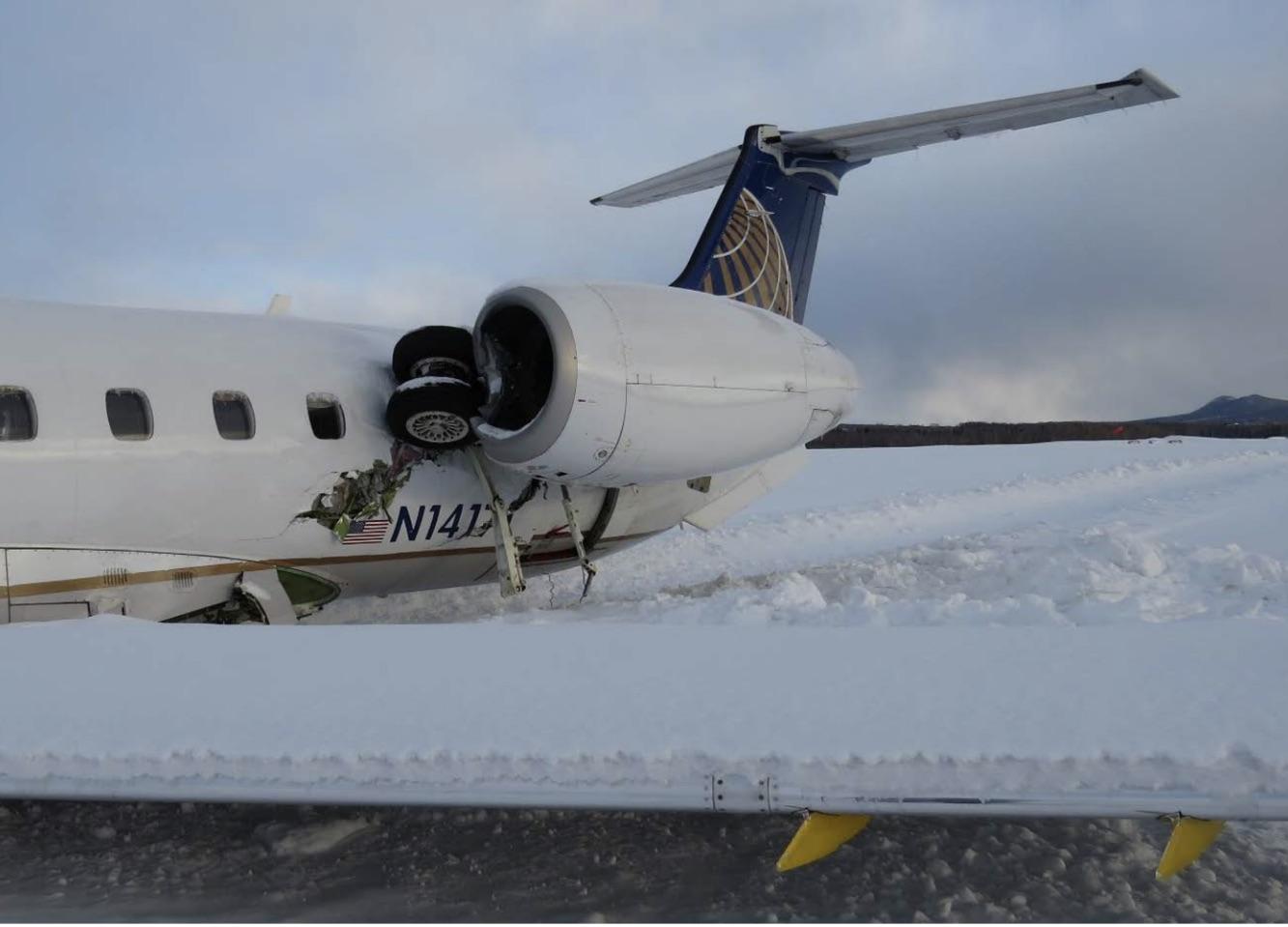
The left main landing gear of the jet lodged between the engine nacelle and the fuselage.
There was a lack of administrative follow-up that may have factored in the missed landing of CommutAir Flight 4933 on March 4, 2019, at Maine's Presque Isle International Airport (PQI).
About 36 hr. before the accident, a different flight crew noted the localizer misalignment while on approach to the airport. After landing, that crew reported the misalignment to a controller at the Air Route Traffic Control Center.
The controller reported the localizer misalignment to FAA technical operations personnel, including the center’s operations manager-in-charge, who then informed the center’s National Airspace System (NAS) operations manager. FAA procedures stated that for reports of a navigational aid malfunction, air traffic control (ATC) personnel should request a report from a second aircraft.
Because a second pilot report had not yet been received to confirm the localizer misalignment, the NAS operations manager did not act on the initial report about the misalignment. The accident flight was the first instrument flight rules flight to arrive at the airport after the initial report about the localizer misalignment.
FAA procedures for ATC personnel also stated, “in the absence of a second aircraft report, activate the standby equipment or request the monitor facility to activate.” But the airport did not have an ATC tower, and air route traffic control centers, including the center involved, do not have the capability to activate standby equipment. Local airport personnel stated that they had no means to determine the alignment of the localizer signal and had to depend on pilot reports.
The earlier misalignment report, however, was not provided to airport personnel. In addition, although FAA winter operations guidance contained specific criteria for the allowable snow depth around a glideslope antenna, the guidance did not specify similar information for the area around a localizer antenna array.
FAA Revises Guidance
After the accident, the FAA revised its winter operations guidance to state that snow around a localizer array could affect its radiated signal and that a snow accumulation level of 2 ft. was the point at which an FAA instrument landing system (ILS) specialist would need to monitor the condition of the localizer signal.
This is a critical observation that we should all keep in mind. At least six pilots who flew into the accident airport during the five days before the accident (including the accident first officer) encountered issues with the ILS localizer. But none of those pilots submitted a company Aviation Safety Action Program (ASAP) report before the accident—although four of the pilots submitted an ASAP report after the accident.
During a post-accident interview, the airline's managing director of safety stated that he did not know why the reports were not filed before the accident. According to the director of operations, a company flight data analyst reviewed ASAP reports “right away,” and the analyst provided time-critical information to the appropriate company managers and directors when necessary.
Because the reports of the localizer misalignment were submitted after the accident, an opportunity was missed to make this information available to company pilots flying to the airport in question and employ strategies to mitigate any potential threat the misalignment posed. For example, the airline could have alerted those pilots to maintain a heightened awareness of the localizer alignment, restricted the use of the Runway 1 ILS approach to higher weather minimums, or prohibited the use of the approach.
In addition, if the Air Route Traffic Control Center involved had received an earlier report of a localizer misalignment, center personnel would have had the opportunity to confirm that report with a second report or take another action to designate the approach as unusable until the localizer signal could be assessed for proper alignment.
Probable Cause Finding
The NTSB determined the probable cause of the accident to be the flight crew’s decision, due to confirmation bias, to continue the descent below the decision altitude when the runway had not been positively identified. Contributing to the accident were: (1) the first officer’s fatigue, which exacerbated his confirmation bias; and (2) the failure of pilots who had observed the localizer misalignment to report it to the company and ATC before the accident.
The majority of this article referenced the NTSB report. I elaborated on the safety board’s findings by further breaking down the links in the chain of events. In my opinion, the link that forged an unbreakable chain was the continued descent below minimums. If that had not occurred, the event could not have happened. The rest of the links were additive, but this is the link that caused the accident.
I am always sure to express that none of my opinions are anything other than that—opinions. Any accident or incident is worth discussing regardless of whether we know the cause of it. I feel free to discuss findings whether substantiated or not. A conjecture of “maybe this happened” might be a thought that prevents a future unbreakable link.
To read Links To A Missed Approach Into The Snow, Part 1, click here.
To read Links To A Missed Approach Into The Snow, Part 2, click here.





